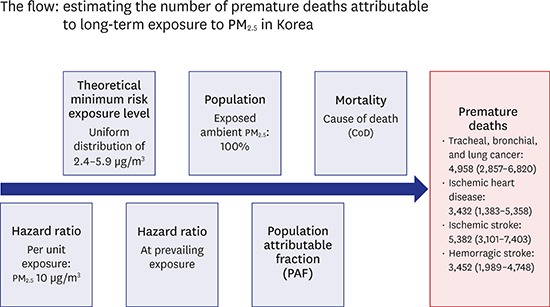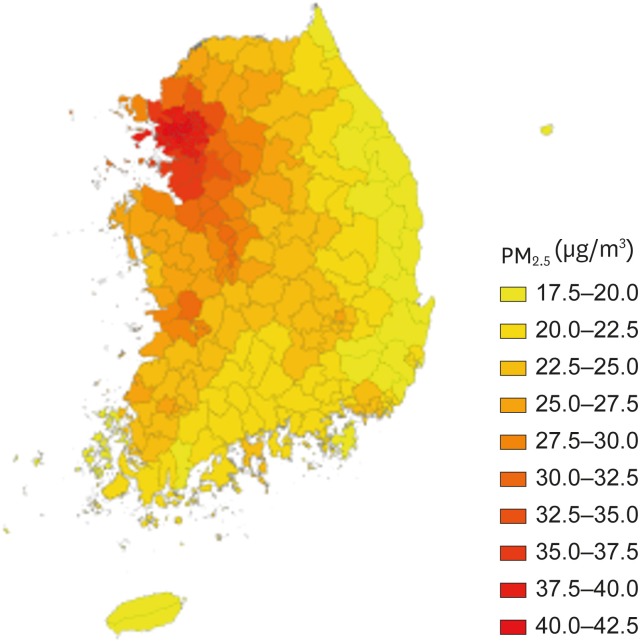INTRODUCTION
Ambient air pollution is recognized as the major environmental health hazard in the Republic of Korea. Exposure to ambient fine particulate matter pollution (PM
2.5) has been associated with increased morbidity and mortality. In 2012, the World Health Organization (WHO) announced that 1 in 8 individuals died from air pollution-related diseases, of which about 3.5 million deaths were caused by exposure to ambient air pollutants, worldwide.
12 Globally, about 90% of people live in environments in which the air pollution levels do not meet the air quality guidelines of the WHO.
3 Premature deaths due to air pollution occur most frequently in individuals living in Southeast Asia and the Western Pacific region, including Korea.
1 The most recent global burden of disease (GBD) study ranked PM
2.5 exposure as the ninth biggest risk factor affecting the total disease burden in Korea.
4
PM consists of a complex mixture of metals, as well as solid and liquid particles of organic and inorganic substances suspended in the atmosphere. The components of PM that affect health are iron, nickel, and arsenic, and compounds such as elemental carbon, organic carbon, sulfate, and nitrate.
56 The composition of these mixtures varies depending on the geographical location of each country, the emissions in major industrial facilities, and the amount of fossil fuels burnt for heating and transport.
6789 Particles with smaller diameters penetrate more deeply into the lungs and affect health even at very low concentrations.
10 Because of this, the health effects associated with ambient particles are more focused in the case of PM
2.5 than in the case of PM
10.
Data on PM
2.5 exposure, disease mortality, and comparative risk assessments (CRAs) for each disease are required for the calculation of premature death caused by ambient air pollutants such as PM
2.5.
11 The CRAs for each disease caused by PM
2.5 are mainly derived from long-term cohort studies, and these results are used to calculate the population attributable fraction (PAF) of PM
2.5 for each disease.
11 Because measurement of PM
2.5 concentrations has not been long worldwide, assessment of long-term exposure in epidemiological studies related to PM
2.5 exposure has been challenging.
12 In the past, PM
2.5 exposure has been measured in several cities using routine ground monitoring, and health effects due to long-term exposures have been estimated in cohort studies.
1314 However, because the monitoring sites were mainly located in urban areas, the total area of the country could not be obtained. Hence, the level of exposure across the entire population could not be estimated. Over the last decade, models that estimate PM
2.5 concentrations have been developed using satellite-based remote sensing such as aerosol optical depth (AOD), chemical transport modeling, and ground measurement data.
151617 The development of methodology has enabled the estimation of long-term PM
2.5 exposure in each region. In the health impact assessment, the results of several cohort studies have improved the outcome of CRA, and there has been a significant change in the methodology for estimating the number of premature deaths attributable to PM
2.5 led by the Institute for Health Metrics and Evaluation (IHME) and WHO.
118 In Korea, previous epidemiologic studies related to PM
2.5 exposure were primarily focused on short-term exposure assessments in the metropolitan population. This study aimed to estimate the premature death attributable to long-term PM
2.5 exposure in the Korean population.
DISCUSSION
We estimated the premature deaths associated with long-term exposure to ambient PM2.5 in Korea. The population-weighted ambient PM2.5 exposure concentration from 1990 to 2013 in Korea was 30.2 μg/m3, resulting in a total annual premature death of 17,224.
As PM
2.5 ground measurement data were not available in Korea before the year 2000, it was not possible to estimate the PM
2.5 concentrations in the period before that. This study used exposure data of a spatial resolution of 0.1° × 0.1° coordinate, based on satellite measurement data and by applying the improved estimation algorithm provided by the GBD group.
1516 In order for long-term high-resolution exposure data to be applied to the resident population, there should be little population movement. However, Korea has extreme population movements; about 15% of the total population moves in relation to new city development, change in housing and occupation, each year.
23 Therefore, applying the exposure data to the resident population after calculating the long-term PM
2.5 exposure concentration by region may result in biased outcomes. To resolve this issue, the population-weighted exposure concentration was calculated and applied to the whole population.
In previous GBD studies that focused on the health effects of ambient PM
2.5 exposure, the TMREL reflected the smallest observable value in the area where the human residence on Earth. In the GBD 2010 study, the observable value was 5.8–8.8 μg/m
3. In GBD 2015 study, however, the said value was lower (2.4–5.9 μg/m
3).
418 To reflect these changes, we estimated the number of premature deaths after applying a uniform distribution of 2.4–5.9 μg/m
3 for TMREL.
Garbage codes occupy about 20% of the registration data pertaining to the CoD in Korea. In previous studies, the number of deaths after the garbage codes were redistributed increased by 6.5% in the case of lung cancer, 76.5% in ischemic heart disease, and 33.6% in ischemic stroke.
21 The garbage code reclassification method applied in this study was the same with that applied by other Korean researchers in previous research; the reclassification of CoD showed a similar increase in our results.
Based on the results of the estimation conducted by the WHO in 2012, the number of premature deaths attributable to long-term ambient PM
2.5 exposure in Korea was 11,523 (9,054–13,963).
1 The number of premature deaths due to long-term ambient PM
2.5 exposure, as estimated jointly by the Health Effects Institute and IHME, increased from 13,800 (11,600–16,300) in 2010 to 18,200 (15,100–21,400) in 2015.
24 Although significant differences in the detailed methodology were noted during the calculation process, data on long-term exposure to ambient PM
2.5 were estimated based on satellite measurements, and data on CoD were derived from the national death registry data.
In 2013, the total number of deaths in Korea was 266,000. In this study, the premature deaths due to long-term exposure to ambient PM
2.5 accounted for 6.4% of the total deaths, which is much higher than the average of 4.9% in the European Union (EU) and 4.4% in the Organization for Economic Cooperation and Development (OECD) countries (
Table 5).
24 Premature deaths of a specific disease due to long-term exposure to ambient PM
2.5 is affected by the concentration level of PM
2.5 and the total number of deaths due to a specific disease. Increase in PM
2.5 concentrations and increase in the total number of deaths caused by a specific disease in aging populations contribute to the increase in the number of premature deaths due to long-term exposure to ambient PM
2.5. The proportion of the population aged 65 years and over in Korea, the EU, and OECD countries as of 2013 is 11.9%, 18.2%, and 15.9%, respectively.
2526 The average long-term exposure concentrations of PM
2.5 in Korea, EU, and OECD were 30.2 μg/m
3, 15.5 μg/m
3, and 15.0 μg/m
3, respectively.
27 Because the proportion of the population aged 65 years and over in Korea was lower than that in the EU or OECD countries, the number of premature deaths due to long-term exposure to ambient PM
2.5 was caused by exposure to higher PM
2.5 concentrations rather than by the higher number of deaths due to cardiovascular and respiratory diseases at older ages.
Table 5
Proportion of deaths due to long-term exposure to PM2.5 among total deaths in Korea, the EU, and OECD countries

|
Content |
Korea |
EU (28 countries) |
OECD (35 countries) |
|
Long-term exposure concentration of PM2.5 (µg/m3) |
30.2 |
15.5 |
15.0 |
|
The proportion of the population aged 65 years and over (%) |
11.9 |
18.2 |
15.9 |
|
Proportion of deaths due to long-term exposure to PM2.5 (%) |
6.4 |
4.9 |
4.4 |
Our study had some limitations. First, the PM
2.5 exposure levels, produced by combining satellite measurements, chemical transport modeling data, and ground measurements, may have been overestimated or underestimated in relation to the actual ground measurements. However, since PM
2.5 concentrations were not monitored in Korea before the year 2000, the use of satellite measurement data is the most practical solution to estimate past exposure levels and identify the health effects. Second, the combined model used to estimate the ambient PM
2.5 exposure levels in this study does not reflect the exposure level according to the height from the ground.
2829 According to the 2014 data, 49.6% of Koreans reside in apartments and the proportion of apartment residents in big cities is much higher than that in the rural areas.
30 Therefore, when considering the housing type of Koreans, changes in PM
2.5 concentrations based on height can be an important issue. Although PM
2.5 concentrations differ depending on the height of the apartment, matching the estimated values at ground level can cause the overestimation of ambient PM
2.5 exposures in epidemiological studies.
12 Third, the exposure-risk function used in this study was obtained from the result of cohort studies conducted in North America. Therefore, the race, residential environments, and lifestyles of the target group would have been different from those of the group in Korea; in addition, emergency medical service systems and health insurance systems that can make a difference in the CoD also vary from country to country. Since, in Korea, there is no cohort study that can assess the health effects of long-term exposure to ambient PM
2.5, this study applied the results of the North American study. Considering the impact of the above confounding factors, it is reasonable to apply the results of the Korean cohort studies in the future.
The Korean population entered the “aging society” category in 2000 and is on the verge of entering the “super-aged society” category. In a study conducted on the disease burden due to non-communicable diseases in Korea, the above diseases were ranked high in both sexes.
31 The prevalence rates of ischemic heart disease, ischemic stroke, hemorrhagic stroke and tracheal, and bronchial and lung cancer, the major health effects of long-term PM
2.5 exposure, increase with age. Considering these characteristics, damage to health caused by ambient PM
2.5 exposure will further increase in the near future.
32 According to a study that projected future air pollution levels, the OECD estimated that, in 2060, more than 1,000 people per 1 million population would die prematurely due to exposure to ambient PM
2.5 in Korea and that this would be the highest number of cases reported across all OECD countries.
33
This study used regional population data of the Korean national statistical office to estimate the population-weighted PM2.5 exposure. The garbage codes were redistributed to classify the CoD more precisely. Therefore, our reclassification method is more realistic than the global evaluation method because it reflects the regional population structure in Korea and misclassification pattern.
Unlike lifestyle-related risk factors such as smoking and high-risk drinking, the health risk from exposure to ambient PM2.5 is difficult to avoid through individual efforts alone. Establishing government policies is important in reducing the health damage caused by exposure to ambient PM2.5. The results of this study can be used as a basis for the government to promote policies and secure budgets. They can also act as tools in predicting and evaluating the health effects of future policy implementation.









 PDF
PDF Citation
Citation Print
Print






 XML Download
XML Download